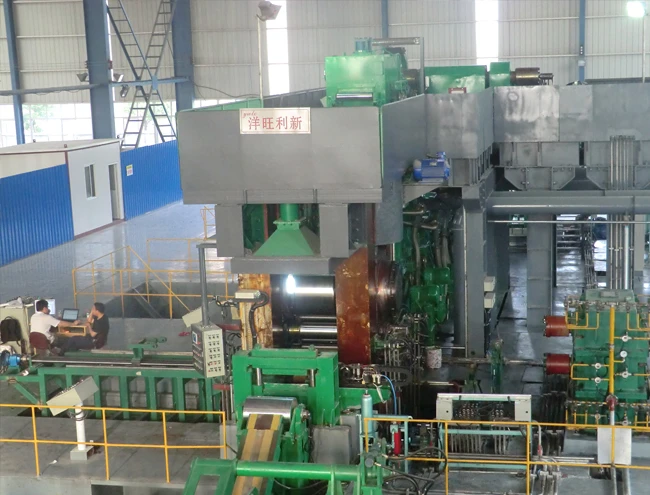
Cladding Rolling Mill - Beijing Yang Wang Li Xin Sci&Tech Co., Ltd.
In the ever-evolving landscape of industrial manufacturing, the Cladding Rolling Mill has emerged as a game-changer. Developed by Beijing Yang Wang Li Xin Sci&Tech Co., Ltd., this innovative technology addresses critical challenges in surface quality, energy efficiency, and production cost. This article explores the technical features, advantages, applications, and company background of this cutting-edge solution, while incorporating authoritative insights from the National Institute of Standards and Technology (NIST).
Technical Features of the Cladding Rolling Mill
The Cladding Rolling Mill stands out for its advanced technical specifications, which ensure superior performance and sustainability. One of its key features is the cold rolling process, which eliminates the need for acid pickling treatment. This results in a high-quality surface finish free from oxides, a critical factor for applications in sensitive industries like electronics and chemical manufacturing.
Another significant advantage is its energy-efficient design. By eliminating the reheat process before rolling and avoiding acid pickling after rolling, the mill aligns with global environmental protection standards. This not only reduces energy consumption but also minimizes waste, making it a sustainable choice for modern factories.
The process is streamlined into three main phases: surface treatment before rolling, bonding rolling, and annealing treatment. This simplicity translates to a high yield rate of over 90% and reduced production costs, making it an economically viable option for manufacturers.

Advantages of the Cladding Rolling Mill
The Cladding Rolling Mill offers a range of benefits that position it as a leader in metal bonding technology. Its cold rolling process ensures a smooth, oxide-free surface, which is essential for applications requiring high aesthetic and functional standards. This is particularly valuable in the automotive and decorative materials industries, where surface quality directly impacts product appeal and durability.
The energy conservation aspect of the mill is another major advantage. By reducing energy consumption during production, it helps companies meet stringent environmental regulations. According to NIST, energy-efficient technologies are critical for reducing carbon footprints and promoting sustainable industrial practices (NIST, 2023).
The mill's simplified process also leads to lower investment costs and faster production cycles. This is especially beneficial for small to medium-sized enterprises looking to adopt advanced manufacturing techniques without significant capital expenditure.

Applications of the Cladding Rolling Mill
The versatility of the Cladding Rolling Mill makes it suitable for a wide range of industries. In the electronic industry, it is used to produce high-conductivity copper-steel or aluminum-steel strips, which are essential for heat dissipation and electrical components. Its ability to bond bimetallic or triple-metallic materials in a single production line enhances efficiency and reduces material waste.
In the chemical industry, the mill's corrosion-resistant cladding strips are used in pipelines and storage tanks. These materials provide a protective layer that prevents chemical reactions, ensuring the longevity of equipment and the safety of operations. The hot roll bonding cladding technology is particularly effective in creating durable, high-performance components for harsh environments.
The automotive industry also benefits from this technology. Lightweight, high-strength cladding strips are used in vehicle body panels and structural components, contributing to fuel efficiency and safety. Additionally, the mill's capability to produce thin strips (as thin as 0.2mm) allows for the creation of intricate parts that meet modern design requirements.
Company Background: Beijing Yang Wang Li Xin Sci&Tech Co., Ltd.
Founded in Beijing Yang Wang Li Xin Sci&Tech Co., Ltd., the company has established itself as a leader in metal bonding technology. With a focus on innovation and sustainability, the company has developed a comprehensive range of cold rolling cladding technologies, including copper-steel, aluminum-steel, and stainless steel-steel combinations. Their expertise in clad pipe welding further expands their capabilities in industrial applications.
The company's commitment to quality is evident in its cold rolling cladding technology, which has been successfully implemented in real-world production. Their ability to produce cladding coils with a width of up to 1000mm and a minimum thickness of 0.2mm demonstrates their technical prowess and adaptability to diverse market needs.
Technical Specifications Table
| Parameter | Specification |
|---|---|
| Rolling Process | Cold Rolling |
| Surface Treatment | None required (oxide-free) |
| Energy Consumption | Low (no reheat or acid pickling) |
| Yield Rate | Over 90% |
| Production Phases | Surface Treatment, Bonding Rolling, Annealing |
| Material Compatibility | Copper-Steel, Aluminum-Steel, Stainless Steel-Steel, etc. |
| Maximum Strip Width | 1000mm |
| Minimum Thickness | 0.2mm |
Conclusion
The Cladding Rolling Mill by Beijing Yang Wang Li Xin Sci&Tech Co., Ltd. represents a significant advancement in metal bonding technology. Its combination of energy efficiency, high yield, and superior surface quality makes it an ideal solution for modern manufacturers. As industries continue to prioritize sustainability and cost-effectiveness, this technology is poised to play a pivotal role in shaping the future of metal production.
References
National Institute of Standards and Technology (NIST). (2023). Energy Efficiency in Industrial Processes. Retrieved from https://www.nist.gov/
-
YWLX’s 1450mm Six-Hi Reversing Mill Goes Live in BangladeshNewsNov.24,2025
-
Adjusting Roll Gap in 6Hi Reversing Cold Rolling Mill for Thin StripNewsNov.13,2025
-
Quality Control Standards for Automatic Gauge Control in Strip RollingNewsNov.13,2025
-
Effect of Skin Pass Rolling on Metal DuctilityNewsNov.13,2025
-
Key Components of a Modern TempermillNewsNov.13,2025
-
Common Wear Patterns of Work Roll in Tandem Cold Mill OperationsNewsNov.13,2025
-
Revolutionary Skin Pass Rolling Technology for Enhanced Steel QualityNewsNov.04,2025










